Great Moments in the History of Solar Physics (2)
1645-1859
bottom of page
1645-1715: Sunspots vanish
Sunspots observations continued in the seventeenth century, with the most active observers being the German
Johannes Hevelius (1611-1687) and the French Jesuit Jean Picard (1620-1682). Very few sunspots were observed from about 1645 to 1715, and when they were their presence was noted as a noteworthy event by active astronomers. At that time, a systematic solar observing program was underway under the direction of Jean Dominique Cassini (1625-1712) at the newly founded Observatoire de Paris, with first Picard and later Philippe La Hire carrying out the bulk of the observations. Historical reconstructions of sunspot numbers indicate that the dearth of sunspots is real, rather than the consequence of a lack of diligent observers. A simultaneous decrease in auroral counts further suggest that solar activity was greatly reduced during this time period.
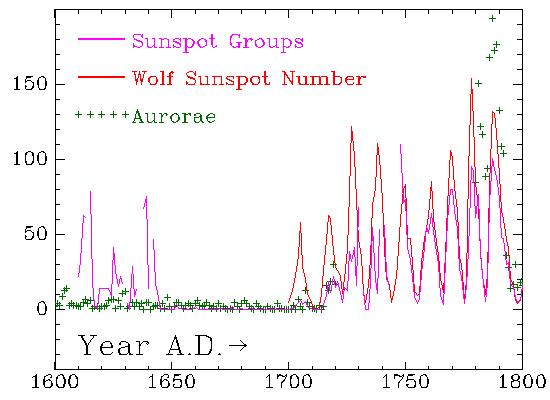
This very anachronistic plot shows the variation in observed sunspot numbers during the time period 1600-1800. The red curve is the Wolf sunspot number, and the purple line a count of sunspot groups based on a reconstruction by D.V. Hoyt. The green crosses are auroral counts, based on a reconstruction by K. Krivsky and J.P. Legrand.
This period is now known as the Maunder minimum , after the solar astronomer E.W. Maunder, who, following the pioneering historical investigations of Gustav Spörer (1822-1895), was most active and steadfast in investigating the dearth of sunspot sightings by astronomers active in the second half of the seventeenth century. The documented occurrence of exceptionally cold winters throughout Europe during those years may be causally related to reduced solar activity, although this remains a topic of controversy.
References and further readings:
Eddy, J.A. 1976, The Maunder Minimum, Science , 192 , 1189-1203.
Eddy, J.A. 1983, The Maunder minimum: a reappraisal, Solar Phys. , 89 , 195-207.
Ribes, J. C., and Nesme-Ribes, E. 1993, The solar sunspot cycle in the Maunder minimum AD1645 to AD1715, Astronomy and Astrophysics , 276 , 549-563.
Hoyt, D.V. & Schatten, K.H. 1997, The Role of the Sun in Climate Change , Oxford University Press.
--------------------------------------------------------------------------------
1687: The mass of the Sun
The mass of the Sun and its distance from the Earth are two very fundamental quantities that were only determined with reasonable accuracy in the eighteenth century. The first quantitative estimate of the Sun's mass is due to Isaac Newton (1642-1727). Newton presented the calculation in his Principia Mathematica , making use of his newly formulated law of universal gravitation. Newton argued that stable planetary orbits resulted from a balance between centripetal and gravitational acceleration; In doing so he could finally provide a physical explanation for the three laws of planetary motions established empirically by Kepler . The ratio of Sun-to-Earth mass can be in principle determined, without knowing the actual value of the universal gravitational constant. This only required a knowledge of orbital periods and radii. Newton, however, used too high a value for the solar parallax, thus grossly underestimating the Sun-Earth distance, and, consequently, underestimating the Sun-to-Earth mass ratio by more than a factor of ten (M Earth /M Sun =28700 instead of 332945). In later editions of his Principia (in 1713 and 1726), Newton used improved estimates of the solar parallax, and brought his estimate to within a factor of two of the modern value
References and further readings:
Wilson, C. 1989, The Newtonian achievement in Astronomy, in The General History of Astronomy , vol. 2A, eds. R. Taton and C. Wilson, Cambridge University Press, pps. 234-274.
Hufbauer, K. 1991, Exploring the Sun , The Johns Hopkins University Press.
--------------------------------------------------------------------------------
1774-1801: The Physical nature of sunspots
The physical nature of sunspots remained a topic of controversy for nearly three centuries. The universally opinionated Galileo proposed, with unusual reservation, that sunspots may perhaps be cloud-like structures in the solar atmosphere. Scheiner believed them to be dense objects embedded in the Sun's luminous atmosphere. In the late eighteenth century William Herschel (1738-1822; discoverer of the planet Uranus), following an hypothesis earlier put forth by A. Wilson in 1774, suggested that sunspots were opening in the Sun's luminous atmosphere, allowing a view of the underlying, cooler surface of the Sun (likely inhabited, in Herschel's then influential opinion).
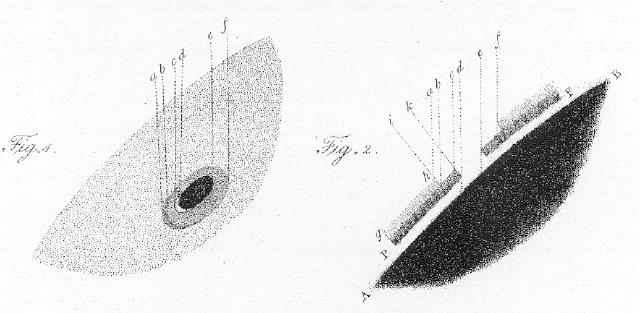
Reproduction of one of Herschel original diagram on the nature of sunspots. This hypothesis relies heavily on the asymmetric appearance of sunspots when seen near the solar limbs, as originally pointed out by A. Wilson in 1774 [from: Phil. Trans. 1801, vol. 91, pp. 265-318 (plate 18)].
References and further readings:
Berry, A. 1898, A Short History of Astronomy (Dover Reprint), chap. 12 Hufbauer, K. 1991, Exploring the Sun , The Johns Hopkins University Press.
--------------------------------------------------------------------------------
1796: The nebular hypothesis and the Sun's origin
By the closing decade of the eighteenth century, the increasingly powerful reflecting telescopes built by the German-born English astronomer William Herschel (1738-1822) had revealed the existence of a number of diffuse cloud-like structures, dubbed Nebulae . Inspired by these observations, the French astronomer and mathematician Pierre Simon de Laplace (1749-1827) put forth his nebular hypothesis , according to which the sun and solar system formed from the gravitational collapse of an initially slowly rotating, large but diffuse gas cloud.
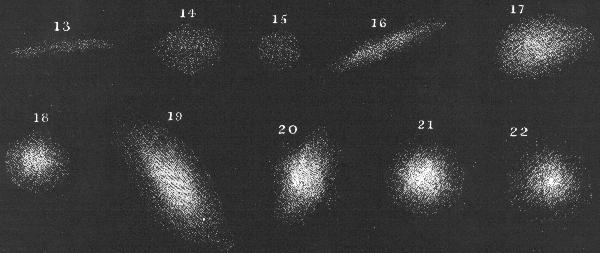
Drawing of Nebulae by William Herschell. Herschell believed that these assorted Nebulae could be interpreted as different snapshots of an evolutionary sequence of gravitational collapse into one or more stars, along the lines proposed by Laplace. Reproduced from W. Herschel, Philosophical Transactions of the Royal Society of London 101 (1811), 269-336 (p. 336, Plate IV).
Laplace's cosmological ideas were described in a popular work, published in 1796 and entitled Exposition du système du monde . This marked a turning point in the history of science, since therein he categorically rejects the Biblical account of the creation of the Universe, and offers instead a physically-based theory that, in its main thrust if not in all details, remains valid to this day.
References and further readings:
Herschel, W. 1811, Astronomical Observations Relating to the Construction of the Heavens..., Philosophical Transactions of the Royal Society of London 90 , 284-292
Hoskin, M. (ed.) 1997, The Cambridge Illustrated History of Astronomy , Cambridge University Press, chap. 6
--------------------------------------------------------------------------------
1800: The Sun's invisible radiation
In the 1660's Isaac Newton had shown that sunlight can be separated into separate chromatic components via refraction through a glass prism. In 1800, William Herschel extended Newton's experiment by demonstrating that invisible "rays" existed beyond the red end of the solar spectrum. He did so by detecting the temperature rise in thermometers placed beyond the red end of the visible solar spectrum.
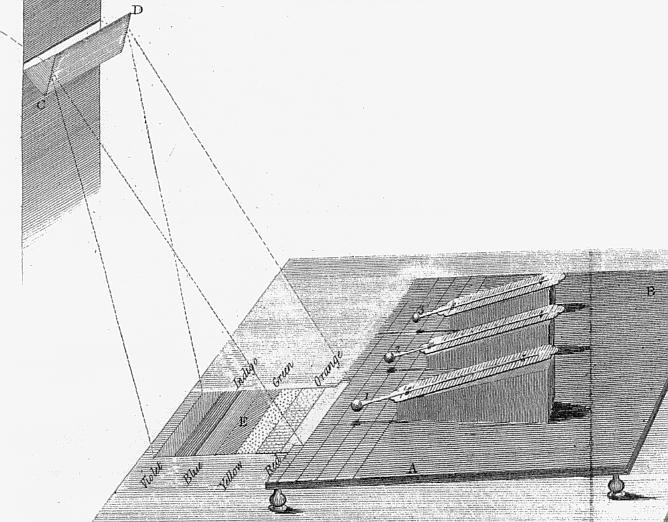
Herschel's experimental setup for the detection of invisible solar radiation. Sunlight passes through a prism (CD), forming the usual rainbow spectrum (E). A row of thermometers is positioned on a table (AB) beyond the red end of the spectrum. Thermometer 1, aligned with the spectrum, registers a rise in temperature, while the control thermometers 2 and 3 do not.
Herschel boldly conjectured that these invisible caloric rays, later named infrared radiation , were fundamentally no different from visible light, and could not be seen simply because the eye is not sensitive to them. Herschell also sought caloric rays beyond the violet end of the spectrum, but to no avail. However, the following year, Johann Wilhelm Ritter (1776-1810) used an experimental setup similar to Herschel's, but placed beyond the violet end of the spectrum a piece of paper soaked in silver chloride; the subsequent blackening of the paper beyond the visible violet demonstrated the existence of ultraviolet radiation . The following year, and using similar photochemical means, William Hyde Wollaston (1766-1828) independently rediscovered ultraviolet radiation.
References and further readings:
Herschel, W. 1800, Experiments on the Refrangibility of the Invisible Rays of the Sun, Philosophical Transactions of the Royal Society of London 90 , 284-292
Meadows, A.J. 1970, Early Solar Physics , Pergamon Press.
--------------------------------------------------------------------------------
1802: Black lines in sunlight
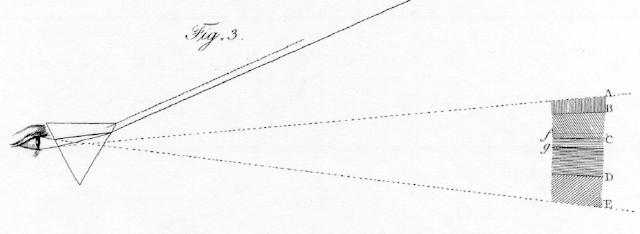
Wollaston's experimental setup for the prismatic observation of the solar spectrum. Wollaston believed that the lines labeled here B, C and E marked natural color boundaries, although he also noticed other dark lines (f,g) that did not appear to delineate colors. Reproduced from Philosophical Transactions of the Royal Society of London , vol. 92 (1802), p. 380 (Plate XIV).
While investigating the refractive properties of various transparent substances, the English chemist and physicist William Hyde Wollaston (1766-1828) noticed dark lines in the spectrum of the Sun, as viewed through a glass prism following the method of Isaac Newton . Beyond suggesting that these dark lines marked the boundaries of "natural colors", Wollaston did not pursue the matter much further. Yet this marked the first step towards solar spectroscopy, which was to revolutionalize Solar Physics in the second half of the century.
References and further readings:
Wollaston, W. H. 1802, A Method of Examinimg Refractive and Dispersive Powers, by Prismatic Reflection Philosophical Transactions of the Royal Society of London 92 , 365-380
Meadows, A.J. 1970, Early Solar Physics , Pergamon Press.
--------------------------------------------------------------------------------
1817: Solar spectroscopy is born
In what was to later lead to some of the more important advances in solar physics, Joseph von Fraunhofer (1787-1826) independently rediscovered the 'dark lines' in the solar spectrum noticed 15 years earlier by William Hyde Wollaston (1766-1828). Fraunhofer pursued the matter mainly because he saw the possibility of using the lines as wavelength standards to be used to determine the index of refraction of optical glasses. Other physicists, however, were quick to realize that the Fraunhofer lines could be used to infer properties of the solar atmosphere, as similar lines were being observed in the laboratory in the spectrum of white light passing through heated gases.
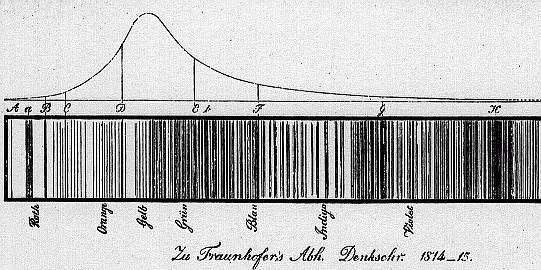
Reproduction of Fraunhofer's original 1817 drawing of the solar spectrum. The more prominent dark lines are labeled alphabetically; some of this nomenclature has survived to this day [from: Denkschriften der K. Acad. der Wissenschaften zu München 1814-15, pp. 193-226]. Compare this to Wollaston's drawing .
In the hands of David Brewster (1781-1868), Gustav Kirchhoff (1824-1887), Robert Wilhelm Bunsen (1811-1899), and Anders Jonas Ångström (1814-1874), to name but a few, spectroscopy turned into a true science which revolutionized not only solar physics, but also astronomy at large. Still today, most information gathered on the Sun and stars is obtained through spectroscopic means.
References and further readings:
Meadows, A.J. 1970, Early Solar Physics , Pergamon Press.
--------------------------------------------------------------------------------
1838: The solar constant
The solar constant is a measure of the sun's luminosity, and is defined by convention as the amount of energy incident per second on one square meter of the outer terrestrial atmosphere, when the Earth is at a distance of one astronomical unit (149,598,500 km) from the Sun.
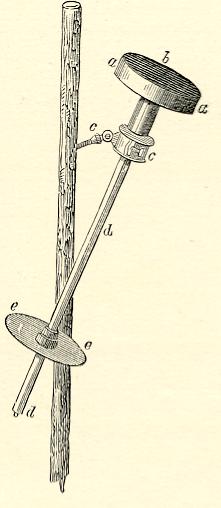 |
Pouillet's pyrheliometer. Water is contained in the cylindrical container a , with the sun-facing side b painted black. The thermometer d is shielded from the Sun by the container, and the circular plate e is used to align the instrument by ensuring that the container's shadow is entirely projected upon it. [Reproduced from A.C. Young's The Sun (revised edition, 1897). |
Although various scientists had attempted to calculate the Sun's energy output, the first attempts at a direct measurement were carried out independently and more or less simultaneously by the French physicist Claude Pouillet (1790-1868) and British astronomer John Herschel (1792-1871). Although they each designed different apparatus, the underlying principles were the same: a known mass of water is exposed to sunlight for a fixed period of time, and the accompanying rise in temperature recorded with a thermometer. The energy input rate from sunlight is then readily calculated, knowing the heat capacity of water. Their inferred value for the solar constant was about half the accepted modern value of 1367 ± 4 Watt per square meter, because they failed to account for of absorption by the Earth's atmosphere.
References and further readings:
Young, C.A. 1897, The Sun (revised ed.), Appleton and Co., chap. 8
Hufbauer, K. 1991, Exploring the Sun , The Johns Hopkins University Press.
--------------------------------------------------------------------------------
1843: The sunspot cycle
Early sunspots observers noted the curious fact that sunspots rarely appear outside of a latitudinal band of about ± 30° centered about the solar equator, but otherwise failed to discover any clear pattern in the appearance and disappearance of sunspots. In 1826, the German amateur astronomer Samuel Heinrich Schwabe (1789-1875), set himself about the task of discovering intra-mercurial planets, whose existence had been conjectured for centuries. Like many before him, Schwabe realized that his best chances of detecting such planets lay with the observation of the apparent shadows that they would cast upon crossing the visible solar disk during conjunction; the primary difficulty with this research program was the ever-present danger of confusing such planets with small sunspots. Accordingly, Schwabe began recording very meticulously the position of any sunspot visible on the solar disk on any day that weather would permit solar observation. In 1843, after 17 years of observations, Schwabe had not found a single intra-mercurial planet, but had discovered something else of great importance: the cyclic increase and decrease with time of the average number of sunspot visible on the Sun, with a period that Schwabe originally estimated to be 10 years.
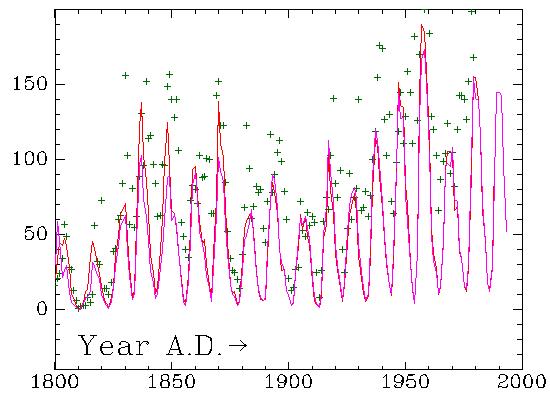
Variation in observed sunspot numbers during the time period 1800-present. The red curve is the Wolf sunspot number, and the purple line a count of sunspot groups based on a reconstruction by D.V. Hoyt. The green crosses are auroral counts, based on a reconstruction by K. Krivsky and J.P. Legrand.
References and further readings:
Stix, M. 1989, The Sun , Springer.
--------------------------------------------------------------------------------
1845: The first solar photograph
The first photographic technique was developed in the 1830's by J. N. Niepce (1765-1833) and Louis Daguerre (1789-1851), and relied on the exposure of a thin iodine layer deposited on a silver substrate, subsequently fixed in a mercury bath. The images so produced became known as daguerrotypes . This imaging technique was very soon applied to astronomy, through the enthusiastic support of the French astronomer and politician Francois Arago (1786-1853), and the British astronomer John Herschel (1792-1871, son of William Herschel ), who first coined the term "photography", as well as "positive" and "negative" images.
The first successful daguerrotype of the Sun, reproduced below, was made on 2 April 1845 by the French physicists Louis Fizeau (1819-1896) and Léon Foucault (1819-1868) (the two being perhaps better known for their various pioneering measurements of the speed of light). The exposure was 1/60 of a second. This image shows the umbra/penumbra structure of sunspots, as well as limb darkening.
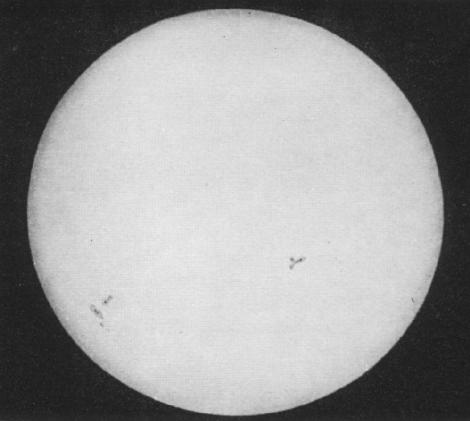
Reproduction of the first daguerrotype of the Sun. The original image was a little over 12 centimeters in diameter. Reproduced from G. De Vaucouleurs, Astronomical Photography , MacMillan, 1961 [plate 1].
Daguerre's photographic process was soon supplanted by a new technique developed starting in 1851, based on a colloidal suspension on a glass substrate, in essence the direct ancestor of modern photographic film. In 1858 daily photographic record of the solar disk using a solar telescope especially designed for photography began at Kew, in England, under the leadership of Warren De la Rue (1815-1889). Photographic techniques were soon thereafter applied to the study of prominences, solar granulation, and solar spectroscopy, with some of the more spectacular results of the period obtained by Jules Janssen (1824-1907) at Meudon, near Paris. The first photograph of a solar prominence was captured by Charles A. Young (1834-1908) in 1870.
The first useful Daguerrotype of a solar eclipse was secured on 28 July 1851 by the photographer/astronomer Berkowski at the Königsberg observatory (then in Prussia, now Kalinigrad in Russia). De la Rue's group also obtained many fine photographs of the 18 July 1860 total eclipse in Spain. Eclipse photographic techniques were further improved by the introduction of radial gradient filters, designed to differentially attenuate the innermost, brightest portion of the corona. The resulting photographs allow to discern details of coronal structure out to many solar radii; see for example slide 9 and slide 10 of the HAO slide set.
References and further readings:
De Vaucouleurs, G. 1961, Astronomical Photography, New York: MacMillan.
Lankford, J. 1984, The impact of photography on astronomy, in The General History of Astronomy, vol. 4A, ed. O. Gingerich, Cambridge University Press, pps. 16-39.
--------------------------------------------------------------------------------
1848: The sunspot number
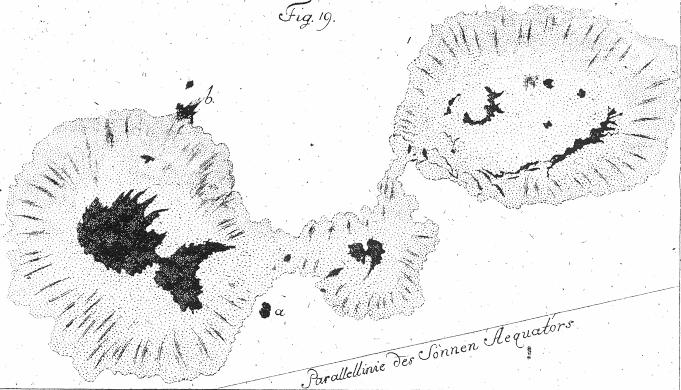
Sunspot drawings by Johann Hieronymus Schroeter (1745-1816), an active solar observer between 1785 and 1795. Schroeter's sunspot drawings were a primary source for Wolf's reconstruction of activity cycle number 4 (1785--1798)
As Schwabe's discovery of the sunspot cycle gained recognition, the question immediately arose as to whether the cycle could be traced farther in the past on the basis of extant sunspot observations. In this endeavour the most active researcher was without doubt the Swiss astronomer Rudolf Wolf (1816-1893). Faced with the daunting task of comparing sunspot observations carried out by many different astronomers using various instruments and observing techniques, Wolf defined the relative sunspot number ( r ) as follows:
r=k(f+10g)
where g is the number of sunspots groups visible on the solar disk, f is the number of individual sunspots (including those distinguishable within groups), and k is a correction factor that varies from one observer to the next (with k=1 for Wolf's own observations, by definition). This definition is still in use today, but r is now usually called the Wolf (or Zürich) sunspot number. Wolf succeeded in reliably reconstructing the variations in sunspot number as far as the The 1755--1766 cycle, which has has since been known conventionally as "Cycle 1", with all subsequent cycles numbered consecutively thereafter; at this writing (January 2000), we are in the rising phase of cycle 23.
References and further readings:
Hoyt, D.V. & Schatten, K.H. 1997, The Role of the Sun in Climate Change , Oxford University Press.
Hoyt, D.V. & Schatten, K.H. 1998, Group sunspot numbers: a new solar activity indicator, Solar Physics , 181 , 491-512.
--------------------------------------------------------------------------------
1852: The sunspot cycle is linked to geomagnetic activity
In 1852, within a year of the publication of Schwabe's results in Kosmos , Edward Sabine (1788-1883) announced that the sunspot cycle period was "absolutely identical" to that of geomagnetic activity, for which reliable data had been accumulated since the mid-1830s. In fact three other researchers arrived at the same conclusion independently and more or less simultaneously: Rudolf Wolf (1816-1893) and Jean-Alfred Gautier (1793-1881), both in Switzerland, and Johann von Lamont (1805-1879) in Germany. This marked the beginning of solar-terrestrial interaction studies.
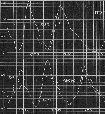
 Click here to view a full size diagram
Click here to view a full size diagram
The correlation between sunspot number and geomagnetic activity index. Diagram reproduced from A.C. Young's The Sun (revised edition, 1897).
References and further readings:
Hoyt, D.V. & Schatten, K.H. 1997, The Role of the Sun in Climate Change , Oxford University Press. Kivelson, M.G., and Russell, C.T. (eds.) 1995, Introduction to Space Physics , Cambridge University Press, chap. 1.
--------------------------------------------------------------------------------
1858-1859: The Sun's differential rotation
Early nineteenth century solar astronomers were increasingly intrigued at the fact that determinations of the solar rotation period obtained by tracking sunspots carried out over the preceding two centuries varied between anywhere from 25 to 28 days. This difference, while small, was significantly larger than the accuracy with which good observers could track sunspot motion.
The resolution of this puzzle came in 1858, when Richard C. Carrington (1826-1875) in England and shortly thereafter Gustav Spörer (1822-1895) in Germany independently made two key discoveries. First, the latitude at which sunspots are most often seen decreases systematically from about 40° to 5° latitude as the sunspot cycle proceeds from one minimum to the next (see diagram below). Second, sunspots located at higher latitudes are carried around the sun more slowly than spots at lower latitudes. From this, Carrington concluded that the Sun rotates differentially , yet another argument in favor of the fluid or gaseous nature of the Sun's outer layers. The aforementioned historical discrepancies are then explained by the fact that different astronomers simply observed the Sun at different epochs of the cycle.
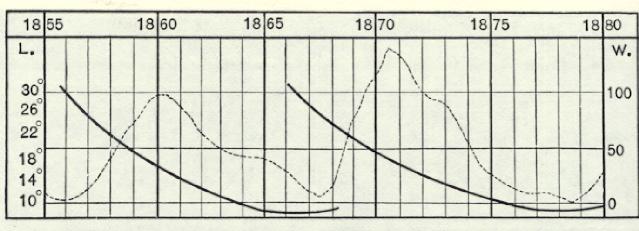
Spörer's Law of sunspot migration. The thick lines shows the latitude at which most sunspots are found (vertical axis, equator is at zero), as a function of time (horizontal axis). The dashed line is the Wolf sunspot number, showing the rise and fall of the solar cycle.
The rapid development of spectroscopic techniques in the second half of the nineteenth century offered another mean of measuring the surface differential rotation, one moreover that is not restricted to latitudes where sunspots are present: measurement of the wavelength shift of spectral lines between the approaching receding solar limb, as a consequence of the Doppler effect. This was first carried out by Hermann Vogel (1841-1907) in 1871, and a few years after by Charles Young (1834-1908). These results were accurate enough to demonstrate that sunspots rotate at very nearly the same rate as the sun's photosphere. By the late 1880's Nils Dúner (1839-1914) had secured accurate spectroscopic rotational period determinations at latitudes about twice higher than the sunspot belts, demonstrating that the Sun's polar regions rotate about 30% more slowly than its equator.
Interestingly, Christoph Scheiner had already noted in his 1630 Rosa Ursina that the rotation period inferred from tacking sunspots at different heliocentric latitudes showed a systematic increase with latitude. However, in Scheiner's Aristotelian framework the Sun could only be a solid, rigidly rotating sphere, and therefore he interpreted his data a proof that sunspots were not markings on the solar surface, but instead cloud-like structures floating above it, since a fluid Sun was "physically absurb". For this reason, most historians of science continue to attribute the discovery of solar differential rotation to Carrington and Spörer.
References and further readings:
Mitchell, W.M. 1916, The History of the Discovery of Solar Spots, Popular Astronomy , 24 , 22-ff.
Eddy, J.A., Gilman, P.A., and Trotter, D.E. 1977, Science , 198 , 824-829
--------------------------------------------------------------------------------
Further General Readings on the history of solar physics and astronomy.
Other Web Sites with material on the history of solar physics.
--------------------------------------------------------------------------------
--------------------------------------------------------------------------------
Did you find factual errors in any of the above documents? If so, we really want to know! please e-mail paulchar@astro.umontreal.ca
--------------------------------------------------------------------------------
-Written by paulchar@astro.umontreal.ca
-Last revised 15 December 2000 by paulchar@astro.umontreal.ca











 Click here to view a full size diagram
Click here to view a full size diagram 